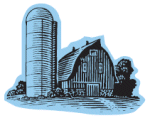

To send a message to an author, click on the author's name at the end of the article.
This Month in Ag Connection | Ag Connection - Other Issues Online
A common question in extension offices deals with what is a fair rate to compensate farm employees. The response typically involves asking more questions and then sharing some guidelines. The compensation depends on many things including: responsibilities, capabilities, reliability and experience. As we move into harvest, many farms may need some extra help.

USDA National Ag Statistics Service (NASS) each year releases a report in the spring concerning farm labor over the past year and it includes rates paid by region. NASS collects data periodically (typically quarterly) throughout the year. Missouri and Iowa make up the region called Cornbelt II. The document is over 20 pages, but does include many tables and charts that can be skimmed quick-ly and offers some help in trying to determine fair wages.
One collection period in 2012 was the week of October 7-13. The NASS survey showed wages in the Cornbelt II region during harvest time a year ago averaged $11.87 per hour for field work and $10.84 for livestock work.
Another interesting feature of the report is the wages paid based on gross value of sales. For example, farms with gross sales between $50,000 and $99,000 averaged wages of $10.05, while farms with sales of $250,000 to $499,000 averaged $11.34.
The report is free to browse or download: http://tinyurl.com/NASS-FarmLabor-2013
Source: Mary Sobba, Ag Business Specialist
This Month in Ag Connection | Ag Connection - Other Issues Online
An innovative and exciting new program designed to provide leadership and hands-on training opportunities for women livestock producers in Missouri. The program is designed to reach women who are playing larger roles and making key decisions on the farm. This statewide women's livestock conference will be held on Friday November 8th and Saturday November 9th.
Cost of the program is $100.00 and includes all the meals. For more information and to register, the conference schedule is on MU's Conference website at: http://muconf.missouri.edu where likely participants can click onto "Pearls of Production-Women in Agriculture" or go to http://muconf.m issouri.edu/womenandagriculture/index.html to register.
Source: Wendy Rapp, Livestock Specialist phone: 660-248-2272
This Month in Ag Connection | Ag Connection - Other Issues Online
Highly variable harvest moisture, late and uneven crop maturity and poor weather conditions can expose many weaknesses in terms of grain dryer operations. Management and equipment shortcomings can create significant bottlenecks and frustration among farmers and elevator managers alike. Whether you own and operate your own drying system or deliver to someone else's dryer, long drying times frustrate everybody. The following provides some operational tips to help farmers optimize the performance of a low temperature grain drying system.
Before loading a drying bin, cleaning of the grain should be considered. High concentration of fine material in the center of the bin can produce uneven airflow. Uneven airflow produces uneven movement of the drying front through the grain bulk. In addition, fine material tends to be wetter than grain. Thus, the combination of lower airflow and higher moisture content in the center result in significantly slower drying and greater potential for spoilage in the center compared to grain close to the sidewall. Although fines are more difficult to remove from wet than from dry corn, wet corn should be screen-cleaned if it is to remain in the same bin for storage. A spreader is generally the only feasible way to coming close to a level fill, which is critical in assuring even air distri-bution for drying. Although undesirable, some hand leveling may be needed at times to compensate for uneven spreading. Utilizing a spreader to distribute fines when filling a bin with dry corn can be less effective than combining a grain cleaner and the drawing of a core. Drawing out dry corn multiple times while filling a bin is even more effective than drawing a core once after filling is complete.
The biggest mistake when operating a natural air/low temperature (NA/LT) drying system (i.e., bin dryers operating with natural air, or air heated up to an extra 10°F) is filling it too quickly. Drying time is directly related to the airflow rate, which is a function of grain depth and fan power. The optimum combination of airflow and fan power typically results in a grain depth of 14-16 ft. However, grain depths of 18-21 ft are most typical for NA/LT drying systems. Although more expensive initially, buying diameter is preferable over buying depth, and results in lower operating costs and better system performance.

If the bin is completely filled with corn above 20% in a single batch, by the time the drying front reaches the top layer, the grain could be spoiled and mycotoxins could develop. If moisture contents are above 20%, a drying bin should not be filled in a single batch but rather in layers. The wetter the grain, the shallower the layers should be. Better yet, if several bin dryers are available, layers of grain should be spread into all of them. Distributing the drying load over more than one bin maximizes the drying capacity. Also, early in the season the moisture content is highest. Thus, the wettest grain can be dried closest to the bottom of each bin where the drying potential of the air is highest.
The drying front must be monitored closely. Often layers of higher and lower moisture content grain are added on top of each other. As the drying front moves up through the grain, moisture is added to some layers and removed from others. Monitoring the top layer of the grain mass has to occur over several days. A reading of 18% moisture on one day may increase to a reading of 20% the next day as the drying front pushes through the different moisture layers. When the moisture readings remain consistently below 16-17% for several days, drying is nearing completion.
Finally, low temperature drying cannot always be completed by December. As a matter of fact, after the middle of December the drying potential of the air is too low in most parts of the Midwest. Thus, after the top layer has dropped below 18% moisture and the grain temperature below 30-35°F, the drying fan can be turned off. Fan operation should subsequently occur about once a week for 4 to 6 hours on dry, cool days until the weather turns warmer again in March. Drying to 15% can then be completed by running the fan continuously in the spring. To assure that the top layer is below 18% moisture by mid-December; supplemental heat may be needed in a poor drying year.
Material for this article was obtained from a Purdue University Publication - Optimizing Grain Dryer Operations - http://www.extension.purdue.edu/extmedia/GQ/GQ-15.htm This publication also discusses the operation of other grain drying systems such as: medium temperature in-bin drying, high speed column dryers, and combination drying systems.
Source: Kent Shannon, N.R. Engineering Specialist
This Month in Ag Connection | Ag Connection - Other Issues Online
The income tax calculation for long-term capital gains is getting to be a maze. Not only have the base rates been expanded (0%; 15% or 20%); now additional tax liability (3.8%) can result from the "Medicare surtax on net investment income". To add injury to insult, for taxpayers in the highest ordinary income tax bracket of 39.6%, the effective marginal rate on their long- term capital gain will likely be increased another 1.2% due to the phase-out of person exemptions and itemized deductions.

Thus, for 2013 the effective marginal federal income tax rate on long-term capital gains will be one of the following rates, depending on the level of income: 0%; 15%; 18.8%; 20%; 23.8%; or 25%.
The "Medicare surtax" will impact joint income tax filers with adjusted gross income greater than $250,000 ($200,000 single). The phase-out for itemized deductions will impact joint filers with taxable income over $450,000 ($400,000 single).
Many taxpayers won't know their exact capital gains tax rate until their tax return is finalized. The capital gain tax maze is one of the reasons tax preparation software has become so popular and why most taxpayers should consider utilizing a professional tax return preparer.
Source: Parman R. Green, Ag Business Mgmt. Specialist
This Month in Ag Connection | Ag Connection - Other Issues Online
Spotted Wing Drosophila (SWD) is a small vinegar fly (about 0.1 inches in length) that for the last two years has been causing economic damage to berries, grapes, and softer-fleshed fruit such as peach in several areas of the US including the Midwest. Now, SWD has appeared in Missouri and made its presence felt by fruit growers.
What sets the SWD apart from other types of vinegar flies is the serrated ovipositor that females have. They can attack healthy fruit by cutting through the skin of the fruit and inserting their eggs. The ovipositor breaks through the fruit's skin, which opens the door for fungus, bacteria and molds to enter the fruit. Also, SWD is able to attack some vegetables such as tomatoes and peppers.
The adult SWD lives for about two weeks and each female can lay more than 300 eggs. The larvae hatch and feed inside the fruits, causing them to rot. This insect reproduces so quickly that a few adults can give rise to thousands of flies in just a couple of months.
Use of effective insecticides that are well timed and have good coverage can control SWD through harvest. However, there is a potential for rapid population increase by SWD. Therefore, active management, by monitoring flies and fruit infestation, is critical.
Once the egg is inside the fruit you can't spray to kill the maggot. If you have infested fruit, then sanitation is a big issue. It's important to remove and destroy all infested fruits. That includes all dropped fruit, where overwintering adults can live. Leaving it under the tree will mean the flies will be there the next season.
For more information about monitoring and managing spotted wing drosophila, see the Aug. 2013 issue of Missouri Environment & Garden at ipm.missouri.edu/meg
Lincoln University Cooperative Extension also has resources at www.lincolnu.edu/web/programs-and-projects/ipm
Source: Jaime Pinero, Lincoln University, State IPM Specialist, 573-681-5522, and Bruce Barrett, University of Missouri Extension Entomologist
This Month in Ag Connection | Ag Connection - Other Issues Online

Jared Decker has been appointed Beef Genetics Extension Specialist at the University of Missouri. The position was most recently held by Bob Weaber. Decker will also serve as animal breeding and genetics specialist on the Commercial Agriculture Program's Beef Focus Team.
Decker received his B.S. from New Mexico State University, graduating with top honors. He majored in Animal Science with a minor in Biology. He earned his Ph.D. at the University of Missouri in Genetics, with a Ph.D. minor in Statistics.
On the Extension side, Jared Decker writes a blog about whatever strikes him as interesting in genetics and livestock production. The name of the blog is steakgenomics.blogspot.com.
Asked about his responsibilities with the new appointment, Decker replied, "I will be providing our regional specialists with the information they will need in order to work with the producers integrating new products. My initial approach will be to create internet content for producers to reference as they try to understand the new technologies.
"We are at a point where the technology used to analyze DNA is rapidly changing. The tools we use in animal breeding are also changing. My main focus will be to educate beef producers on how to utilize the new technologies to increase their profits."
Author: Michelle Proctor, Senior Information Specialist
This Month in Ag Connection | Ag Connection - Other Issues Online
Publishing Information
Ag Connection is published monthly for Northeast and Central areas of Missouri producers and is supported by the University of Missouri Extension, the Missouri Agricultural Experiment Station, and the MU College of Agriculture, Food and Natural Resources. Managing Editor: Mary Sobba.